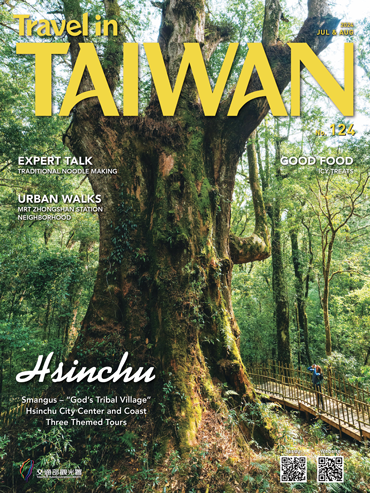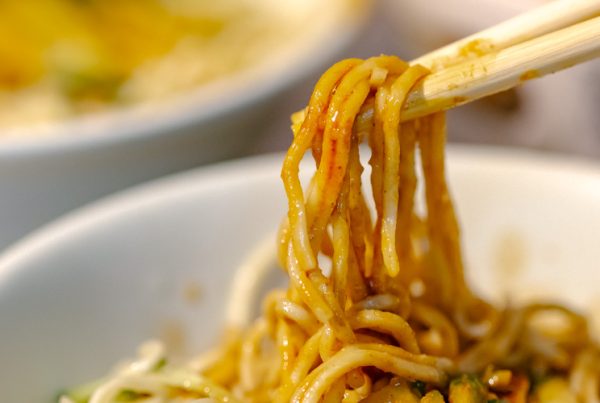Content
A Very Popular Hike in Jiaoxi Township
TEXT / RYAN HEVERN
PHOTOS / RYAN HEVERN, VISION
Yilan County, with its emerald paddy fields spread out over a vast plain between tall mountains and the Pacific Ocean, is a must-visit destination in northeast Taiwan. Jiaoxi Township, located in the north of the county, is especially attractive. Best known for its odorless hot springs, the township also has a more adventurous side for travelers to enjoy. The hike up Mt. Sanjiaolun, following the Marian Hiking Trail, has become extremely popular in recent years. The mountain’s southwest slope, covered in silvergrass and arrow bamboo, has the color of Japanese powder tea (matcha), which is the reason why the mountain has become known simply as Matcha Mountain in Taiwan.
One of Taiwan’s better-known hot-spring destinations, Jiaoxi, is now attracting countless visitors with its combination of pristine environment and several fine options for hiking outings. Apart from Mt. Sanjiaolun, there are also the Wufengqi Scenic Area, Linmei Shipan Trail, and Paoma Historic Trail.
Hiking in Jiaoxi’s mountains can be easily combined with relaxing hot-spring baths at a quality hotel, and since getting there from central Taipei is convenient, the area is perfect for one-day trips from the capital.
The hike up Matcha Mountain rewards you with incredible scenery, and also has an interesting religious component. With a unique Catholic church at the start of the hike and a “Christian” hut below the peak of Mt. Sanjiaolun, hiking the trail has become somewhat of a pilgrimage for hikers of faith.
The Marian Hut was built in 1977 by an Italian monk, Br. Luigi Pavanat, who worked for 20 years in Yilan’s Camillian Saint Mary’s Hospital Luodong and was in love with Taiwan’s mountains. In 1980, a group of hikers met bad weather on a hike to Mt. Sanjiaolun, and took shelter in the hut. Five of the hikers decided to descend the mountain in the dark. On the way down they saw the image of a woman in a long white robe, later confirmed to have been an apparition of the Virgin Mary. The church at the start of the hike, known as the Catholic Sanctuary of Our Lady of Wufengqi, was built years later close to the location of the apparition.


PREPARATION
The Marian Hiking Trail is suitable for most hikers with moderate fitness, but that doesn’t mean it isn’t strenuous. While beautiful photos on the mountain are almost guaranteed, be prepared to sacrifice a large amount of sweat to get there (especially during the hot summer months).
It takes about five hours to get from the car park in the Wufengqi Waterfall area to the Marian Hut and, just above it, a platform with a statue of Jesus on the cross from where you have the best views. The easy-to-follow route has a total length of 5.6km. It consists of a long easy-grade gravel path, a steep-step section through forest, and a dirt path section up along arrow bamboo slopes.
Bring a lot of water when it’s hot, as the only refill option along the trail is a mountain stream. Yilan’s weather can be quite unpredictable, and it’s often wet in the mountains. Be sure to pack a hat, sunscreen, a light rain jacket, snacks, and some sturdy shoes! Also, since Mt. Sanjiaolun is often covered in clouds, do your best to pick a clear-sky day; otherwise you might not be able to see the big vistas once you have reached the top.
THE HIKE
The hike begins at the Wufengqi Scenic Area car park. You can first walk up to the three-tier Wufengqi Waterfall (look for the signposted stairs on the right side of the main path), or you can follow the winding paved road uphill straight ahead. A path connects the waterfall area with this road just below the Catholic church. At the church you want to look down to the Lanyang Plain to get a first taste of what you will later see from much higher up. You can take a look inside the beautiful round church and view a statue of the Virgin Mary in a man-made cave beside the building.
After this, follow the steep road behind the church, which soon becomes a gravel path that brings you to the proper trailhead at the Tongtian Bridge. The trail first follows a mountain stream through lush forest. During hot weather many hikers will opt to sit by the stream, soaking their feet in the cooling water.






Meandering through the luxuriant forest, the well-maintained path takes you past rich vegetation. It’s a steep climb, with a change in elevation of about 400m. While for the first kilometer or so you can enjoy the tree shade, the higher up you go the more the forest opens up. Along the last few hundred meters before reaching the Marian Hut you’ll be surrounded by arrow bamboo, which blankets the mountainside, and you’ll be rewarded with breathtaking unobstructed views of the Lanyang Plain when looking back.

Just above the Marian Hut lies the main attraction on this hike, the rolling matcha-like slopes of Mt. Sanjiaolun, covered in arrow bamboo and silvergrass. When the silvergrass sways in the wind, this becomes an even more mesmerizing landscape. The hut itself is a welcome shelter during unfavorable weather, a place with running water, toilets, and even benches to lie down on.

A short distance above the hut is the viewing platform at the end of the trail, reached by climbing a set of steep steps. The large Jesus on the cross statue stands in the center of the platform, from where you can enjoy stunning 360 degree views of the surrounding verdant mountains, the Lanyang Plain, and the Pacific Ocean in the far distance.

For those who want an extended and more strenuous hike, another trail section continues further up to the peak of Mt. Sanjiaolun. Add at least another hour to your hike if this is the path you choose.
Tip: Take your time hiking down the staired sections to preserve your knees! If you choose to hike on a hot summer day, make sure to relax in the stream for a bit to cool off.
Also read:
Hiking to SHENGMU PEAK near Jiaoxi
Hiking around WUFENGQI in YILAN County
Slippery, Cold, and Wet… RIVER TRACING in JIAOXI
TAIPINGSHAN, QILAN, and YILAN CITY
The SUHUA HIGHWAY in YILAN
AFTER THE HIKE
Hot Spring Parks
The town of Jiaoxi offers two outdoor free-entry hot-spring parks. The Tangweigou Hot Spring Park is located on Jiaoxi Road, just a short walk from the town’s railway station. The Jiaoxi Hot Spring Park is adjacent to the Jiaoxi bus station. There are hot-spring pools in both parks allowing you to dip your feet in comfortably warm water.

The Tangweigou Hot Spring Park has a hot-spring creek running right through it. Surrounding the park’s foot-bath pool area are various food stalls with a variety of options, including one of Yilan’s most popular specialty items: green scallion pancakes! To go along with the food stalls, take a walk around and find a handful of craft beer vendors selling locally brewed beer.
In the surrounding area, for a small fee you can also dip your feet in one of the popular “fish spas,” where tiny fish will nibble at your feet, eating the dead skin. It tickles, but doesn’t hurt, and is quite the unique experience to tell your friends and family about!
Klook offers:
Hot Spring Onion: Art Bath House in Jiaoxi
Jiaoxi Hot Spring Experience in Just Sleep with Optional All-You-Can-Eat Sukiyaki
Double Spring House Experience at MU Jiaoxi Hotel in Yilan
Rakuzan Ramen Restaurant
One of the most unique dining experiences in Taiwan is to be had in Jiaoxi. Combine eating ramen with a hot-spring foot bath! At the Rakuzan Ramen Restaurant, near the Jiaoxi Hot Spring Park, you can choose to sit outside and enjoy a nice hot-spring foot soak while eating delicious ramen paired with Japanese beer. What might seem like a gimmicky restaurant at first glance actually is a fine establishment offering a great menu with mouthwatering ramen, Japanese-style fried-pork dishes, as well as an array of good sashimi and other seafood options.


After a long day of walking in the Jiaoxi mountains, it is a real treat to feel the natural healing effects of mineral hot springs on your feet and legs while indulging the stomach with tasty food and beers.
Note: There are two Rakuzan Ramen Restaurant locations in Jiaoxi. Only the branch near the Jiaoxi Hot Spring Park offers the foot bath experience.
Rakuzan Ramen Restaurant (樂山溫泉拉麵)
Add: No. 20, Gongyuan Rd., Jiaoxi Township, Yilan County
(宜蘭縣礁溪鄉公園路20號)
Tel: (03) 988-8637
Facebook: www.facebook.com/LeShanWenQuanLaMianErDian/







